[English] 日本語
 Yorodumi
Yorodumi- PDB-1qg1: GROWTH FACTOR RECEPTOR BINDING PROTEIN SH2 DOMAIN COMPLEXED WITH ... -
+ Open data
Open data
- Basic information
Basic information
| Entry | Database: PDB / ID: 1qg1 | ||||||
|---|---|---|---|---|---|---|---|
| Title | GROWTH FACTOR RECEPTOR BINDING PROTEIN SH2 DOMAIN COMPLEXED WITH AN SHC-DERIVED PEPTIDE | ||||||
 Components Components |
| ||||||
 Keywords Keywords | HORMONE/GROWTH FACTOR / SIGNAL TRANSDUCTION / SH2 DOMAIN / PHOSPHOTYROSYL PEPTIDE / COMPLEX (SIGNAL TRANSDUCTION-PEPTIDE) / HORMONE-GROWTH FACTOR COMPLEX | ||||||
| Function / homology |  Function and homology information Function and homology informationregulation of superoxide metabolic process / positive regulation of cell proliferation in bone marrow / guanyl-nucleotide exchange factor adaptor activity / Grb2-EGFR complex / branching involved in labyrinthine layer morphogenesis / STAT5 Activation / Co-inhibition by BTLA / XBP1(S) activates chaperone genes / COP9 signalosome / neurotrophin TRKA receptor binding ...regulation of superoxide metabolic process / positive regulation of cell proliferation in bone marrow / guanyl-nucleotide exchange factor adaptor activity / Grb2-EGFR complex / branching involved in labyrinthine layer morphogenesis / STAT5 Activation / Co-inhibition by BTLA / XBP1(S) activates chaperone genes / COP9 signalosome / neurotrophin TRKA receptor binding / Activated NTRK2 signals through PI3K / transmembrane receptor protein tyrosine kinase adaptor activity / MET receptor recycling / Signaling by cytosolic FGFR1 fusion mutants / Interleukin-15 signaling / MET activates PTPN11 / negative regulation of natural killer cell mediated cytotoxicity / MET activates RAP1 and RAC1 / Interleukin-2 signaling / vesicle membrane / Signaling by LTK / CD28 dependent Vav1 pathway / MET activates PI3K/AKT signaling / Signal regulatory protein family interactions / Shc-EGFR complex / epidermal growth factor receptor binding / epidermal growth factor binding / Regulation of KIT signaling / Signaling by ALK / PI-3K cascade:FGFR3 / natural killer cell mediated cytotoxicity / STAT5 activation downstream of FLT3 ITD mutants / PI-3K cascade:FGFR2 / PI-3K cascade:FGFR4 / PI-3K cascade:FGFR1 / positive regulation of actin filament polymerization / endodermal cell differentiation / GRB2:SOS provides linkage to MAPK signaling for Integrins / RHOU GTPase cycle / regulation of MAPK cascade / RET signaling / PI3K events in ERBB2 signaling / insulin receptor substrate binding / Interleukin-3, Interleukin-5 and GM-CSF signaling / PI3K Cascade / SOS-mediated signalling / Activated NTRK3 signals through RAS / Activated NTRK2 signals through RAS / signal transduction in response to DNA damage / fibroblast growth factor receptor signaling pathway / SHC1 events in ERBB4 signaling / RHO GTPases Activate WASPs and WAVEs / Role of LAT2/NTAL/LAB on calcium mobilization / Interleukin receptor SHC signaling / Signalling to RAS / GAB1 signalosome / Signal attenuation / Activated NTRK2 signals through FRS2 and FRS3 / SHC-related events triggered by IGF1R / Schwann cell development / SHC-mediated cascade:FGFR3 / MET activates RAS signaling / SHC-mediated cascade:FGFR2 / Signaling by PDGFRA transmembrane, juxtamembrane and kinase domain mutants / Signaling by PDGFRA extracellular domain mutants / SHC-mediated cascade:FGFR4 / Erythropoietin activates RAS / Signaling by FGFR4 in disease / SHC-mediated cascade:FGFR1 / FRS-mediated FGFR3 signaling / Signaling by CSF3 (G-CSF) / Signaling by FLT3 ITD and TKD mutants / FRS-mediated FGFR2 signaling / FRS-mediated FGFR4 signaling / Signaling by FGFR3 in disease / FRS-mediated FGFR1 signaling / Tie2 Signaling / insulin-like growth factor receptor binding / ephrin receptor binding / Signaling by FGFR2 in disease / GRB2 events in EGFR signaling / phosphotyrosine residue binding / SHC1 events in EGFR signaling / myelination / Integrin signaling / Signaling by FLT3 fusion proteins / FLT3 Signaling / Signaling by FGFR1 in disease / EGFR Transactivation by Gastrin / FCERI mediated Ca+2 mobilization / NCAM signaling for neurite out-growth / GRB2 events in ERBB2 signaling / Downstream signal transduction / SHC1 events in ERBB2 signaling / Insulin receptor signalling cascade / insulin-like growth factor receptor signaling pathway / Antigen activates B Cell Receptor (BCR) leading to generation of second messengers / Constitutive Signaling by Overexpressed ERBB2 / Signaling by phosphorylated juxtamembrane, extracellular and kinase domain KIT mutants / T cell activation Similarity search - Function | ||||||
| Biological species |  Homo sapiens (human) Homo sapiens (human) | ||||||
| Method | SOLUTION NMR | ||||||
 Authors Authors | Ogura, K. | ||||||
 Citation Citation |  Journal: J.Mol.Biol. / Year: 1999 Journal: J.Mol.Biol. / Year: 1999Title: Solution structure of the SH2 domain of Grb2 complexed with the Shc-derived phosphotyrosine-containing peptide. Authors: Ogura, K. / Tsuchiya, S. / Terasawa, H. / Yuzawa, S. / Hatanaka, H. / Mandiyan, V. / Schlessinger, J. / Inagaki, F. | ||||||
| History |
|
- Structure visualization
Structure visualization
| Structure viewer | Molecule:  Molmil Molmil Jmol/JSmol Jmol/JSmol |
|---|
- Downloads & links
Downloads & links
- Download
Download
| PDBx/mmCIF format |  1qg1.cif.gz 1qg1.cif.gz | 49.6 KB | Display |  PDBx/mmCIF format PDBx/mmCIF format |
|---|---|---|---|---|
| PDB format |  pdb1qg1.ent.gz pdb1qg1.ent.gz | 35 KB | Display |  PDB format PDB format |
| PDBx/mmJSON format |  1qg1.json.gz 1qg1.json.gz | Tree view |  PDBx/mmJSON format PDBx/mmJSON format | |
| Others |  Other downloads Other downloads |
-Validation report
| Summary document |  1qg1_validation.pdf.gz 1qg1_validation.pdf.gz | 259.6 KB | Display |  wwPDB validaton report wwPDB validaton report |
|---|---|---|---|---|
| Full document |  1qg1_full_validation.pdf.gz 1qg1_full_validation.pdf.gz | 259.3 KB | Display | |
| Data in XML |  1qg1_validation.xml.gz 1qg1_validation.xml.gz | 7.6 KB | Display | |
| Data in CIF |  1qg1_validation.cif.gz 1qg1_validation.cif.gz | 9.7 KB | Display | |
| Arichive directory |  https://data.pdbj.org/pub/pdb/validation_reports/qg/1qg1 https://data.pdbj.org/pub/pdb/validation_reports/qg/1qg1 ftp://data.pdbj.org/pub/pdb/validation_reports/qg/1qg1 ftp://data.pdbj.org/pub/pdb/validation_reports/qg/1qg1 | HTTPS FTP |
-Related structure data
| Similar structure data |
|---|
- Links
Links
- Assembly
Assembly
| Deposited unit | 
| |||||||||
|---|---|---|---|---|---|---|---|---|---|---|
| 1 |
| |||||||||
| NMR ensembles |
|
- Components
Components
| #1: Protein | Mass: 12012.516 Da / Num. of mol.: 1 / Fragment: SH2 Source method: isolated from a genetically manipulated source Details: RESIDUES HIS-58 - THR-159 AND THE EXTRINSIC N-TERMINAL TWO RESIDUES, GLY-56 AND SER-57 Source: (gene. exp.)  Homo sapiens (human) / Plasmid: BL21 (DE3) Homo sapiens (human) / Plasmid: BL21 (DE3)Gene (production host): PROTEIN WAS EXPRESSED WITH PGEX-4T-2 VECTOR AND BL21 (DE3) CELL AS GST-FUSION PROTEIN, AND CLEAVED WITH TRYPSIN Production host:  |
|---|---|
| #2: Protein/peptide | Mass: 1587.558 Da / Num. of mol.: 1 / Fragment: 423-435 / Source method: obtained synthetically Details: THE PEPTIDE WAS CHEMICALLY SYNTHESIZED BY THE SOLID-PHASE FMOC STRATEGY. THE SEQUENCE OF THIS PEPTIDE IS NATURALLY FOUND IN HOMO SAPIENS (HUMAN). References: UniProt: P29353 |
| Has protein modification | Y |
-Experimental details
-Experiment
| Experiment | Method: SOLUTION NMR |
|---|---|
| NMR details | Text: MEAN STRUCTURE. NULL |
- Sample preparation
Sample preparation
| Sample conditions | pH: 6.3 / Temperature: 301 K |
|---|---|
| Crystal grow | *PLUS Method: other / Details: NMR |
- Processing
Processing
| NMR software |
| ||||||||||||
|---|---|---|---|---|---|---|---|---|---|---|---|---|---|
| NMR ensemble | Conformer selection criteria: LOWEST ENERGY / Conformers calculated total number: 100 / Conformers submitted total number: 1 |
 Movie
Movie Controller
Controller




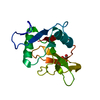

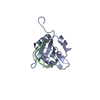

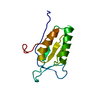
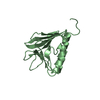

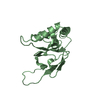
 PDBj
PDBj

















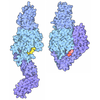



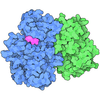


 X-PLOR
X-PLOR